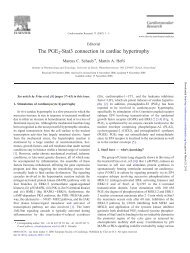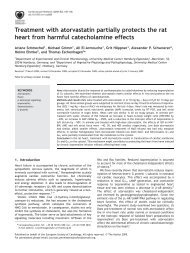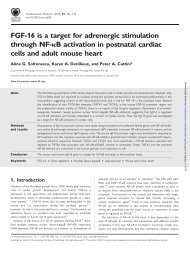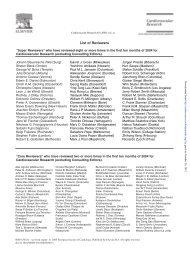Cilostazol inhibits cytokine-induced nuclear factor-kB activation via ...
Cilostazol inhibits cytokine-induced nuclear factor-kB activation via ...
Cilostazol inhibits cytokine-induced nuclear factor-kB activation via ...
You also want an ePaper? Increase the reach of your titles
YUMPU automatically turns print PDFs into web optimized ePapers that Google loves.
Page 2 of 7<br />
The activated <strong>nuclear</strong> <strong>factor</strong> (NF)-<strong>kB</strong> has been identified<br />
in human atherosclerotic plaques, but is absent, or present<br />
only in very small amounts in vessels devoid of atherosclerosis.<br />
11 A number of genes whose products have been implicated<br />
in the development of atherosclerosis are regulated<br />
by NF-<strong>kB</strong>. Various leukocyte adhesion molecules, such<br />
as the vascular cell adhesion molecule-1 (VCAM-1), intercellular<br />
adhesion molecule-1 (ICAM-1), and E-selectin, as<br />
well as various chemokines (chemoattractant <strong>cytokine</strong>s),<br />
monocyte chemoattractant protein-1 (MCP-1), and IL-8,<br />
recruit circulating mono<strong>nuclear</strong> leukocytes to the arterial<br />
intima. 12–14 The induction of other NF-<strong>kB</strong>-dependent<br />
genes, including tissue <strong>factor</strong>s, might tip the pro/<br />
anti-coagulant balance of the endothelium towards coagulation.<br />
Still other products of target genes, including cyclin<br />
D1, may induce cell proliferation or stimulate cell survival at<br />
atherosclerotic deposits. Therefore, the coordinated induction<br />
of NF-<strong>kB</strong>-dependent genes might promote atherosclerosis. 15<br />
<strong>Cilostazol</strong> is unique in that it targets the endothelium,<br />
thereby inhibiting thrombosis and improving endothelial<br />
cell function, and reducing the number of partially activated<br />
platelets by interacting with activated endothelial cells.<br />
However, the exact mechanism by which cilostazol preserves<br />
endothelial function remains to be elucidated. In the present<br />
study, we hypothesized that cilostazol may prevent NF-<strong>kB</strong><br />
<strong>activation</strong> in endothelial cells exposed to inflammatory<br />
<strong>cytokine</strong>s. We examined the effects of cilostazol on NF-<strong>kB</strong><br />
<strong>activation</strong>, as well as the expression of NF-<strong>kB</strong>-mediated<br />
genes, such as VCAM-1, ICAM-1, E-selectin, and MCP-1, in<br />
vascular endothelial cells. We found that cilostazol <strong>inhibits</strong><br />
the <strong>cytokine</strong>-<strong>induced</strong> expression of pro-inflammatory and<br />
adhesion molecule genes by suppressing NF-<strong>kB</strong> activity <strong>via</strong><br />
AMP-activated protein kinase (AMPK) <strong>activation</strong> and not <strong>via</strong><br />
the cyclic AMP (cAMP)/protein kinase A (PKA) pathway.<br />
2. Methods<br />
2.1 Cell culture<br />
Human umbilical vein endothelial cells (HUVEC) were obtained from<br />
Clonetics (San Diego, CA, USA) and cultured in EGM2 medium supplemented<br />
with 2% FCS in the standard fashion. The cells in this<br />
experiment were used within 3–4 passages and were examined to<br />
ensure that they demonstrated the specific characteristics of<br />
endothelial cells. SVEC4 cells (murine endothelial cell line; ATCC,<br />
Rockville, MD, USA) were also cultured in DMEM containing 10%<br />
FCS and observed to demonstrate the typical cobblestone morphological<br />
appearance of endothelial cells. 16 THP-1 cells, a human<br />
monocytic cell line (ATCC), were grown in RPMI-1640 medium<br />
containing 10% FCS.<br />
The investigation conforms with the Guide for the Care and Use of<br />
Laboratory Animals published by the US National Institute of Health<br />
and with the Declaration of Helsinki.<br />
2.2 Western blot analysis<br />
HUVEC treated with tumour necrosis <strong>factor</strong> alpha (TNFa) in the presence<br />
or absence of metformin for various intervals were lysed using<br />
cell lysis buffer (Cell Signalling, Beverly, MA, USA) with 1 mM PMSF.<br />
The protein concentration of each sample was measured using a<br />
Bio-Rad detergent-compatible protein assay. Subsequently,<br />
b-mercaptoethanol was added to a final concentration of 1%,<br />
after which each sample was denatured by boiling for 3 min.<br />
Samples containing 10 mg of protein were resolved by electrophoresis<br />
on 12% sodium dodecyl sulphate (SDS)–polyacrylamide gel<br />
electrophoresis (PAGE) and transferred to a polyvinyldienefluoride<br />
(PVDF) membrane (Bio-Rad, Tokyo, Japan), after which they were<br />
incubated with anti-phospho-Thr-172 AMPK polyclonal antibody<br />
and anti-phospho-Ser-79 acetyl-CoA carboxylase (ACC) polyclonal<br />
antibody (1:1000, Cell Signalling). For the I<strong>kB</strong> experiments, the<br />
membranes were incubated with I<strong>kB</strong>a antibody or phospho-I<strong>kB</strong>a<br />
antibody (1:1000, Cell Signalling). The binding of each of<br />
these antibodies was detected using sheep anti-rabbit IgG horseradish<br />
peroxidase (1:20 000) and an ECL Plus system (Amersham,<br />
Buckinghamshire, UK).<br />
2.3 Nuclear <strong>factor</strong>-<strong>kB</strong> <strong>activation</strong><br />
To study NF-<strong>kB</strong> <strong>activation</strong>, SVEC4 cells were stably transfected with<br />
a cis-reporter plasmid containing the luciferase reporter gene linked<br />
to five repeats of NF-<strong>kB</strong> binding sites (pNF-<strong>kB</strong>-Luc: Stratagene, La<br />
Jolla, CA, USA), as previously described. 17 For this, the pNF-<strong>kB</strong>-Luc<br />
plasmid was transfected, together with a pSV2neo helper plasmid,<br />
(Clontech, Palo Alto, CA, USA) into SVEC4 cells using a FuGEN 6<br />
transfection reagent (Boehringer Mannheim, Mannheim, Germany).<br />
The cells were then cultured in the presence of G418 (Clontech)<br />
at a concentration of 500 mg/mL, and the medium was replaced<br />
every 2–3 days. Approximately 3 weeks after transfection,<br />
G418-resistant clones were isolated using a cloning cylinder and<br />
analysed individually for the expression of luciferase activity.<br />
Several clones were also selected for the analysis of NF-<strong>kB</strong> <strong>activation</strong>.<br />
Luciferase activity was measured using a luciferase assay<br />
kit (Stratagene).<br />
We also measured changes in the levels of NF-<strong>kB</strong> p50 and p65 in<br />
<strong>nuclear</strong> extracts from HUVEC using a transcription <strong>factor</strong> assay kit<br />
(Active Motif Japan, Tokyo, Japan). Nuclear extracts were prepared<br />
with a NE-PER <strong>nuclear</strong> extraction reagent (Pierce, Rockford, IL,<br />
USA), after which p50 and p65 were quantified using recombinant<br />
NF-k B p50 and p65 protein (Active Motif) as the standard.<br />
2.4 I<strong>kB</strong> kinase assay<br />
I<strong>kB</strong> kinase (IKK) activity was examined using an immune complex<br />
kinase assay with GST-I<strong>kB</strong>a (1–55) as the substrate, as previously<br />
described. 18 Briefly, the cells were solubilized in ice-cold buffer,<br />
and then centrifuged at 15 000 g for 20 min. IKKa and IKKb<br />
were recovered from the cell lysate by immunoprecipitation, after<br />
which the immune complexes were incubated with 20 mL of reaction<br />
buffer containing 20 mM HEPES/NaOH (pH 7.4), 10 mM MgCl 2,<br />
50 mM NaCl, 100 mM Na3VO4, 20 mM b-glycerophosphate, 1 mM<br />
DTT, 100 mM ATP, 0.1 mCi [g- 32 P]ATP, and 10 mg GST-I<strong>kB</strong>a (1–55),<br />
at 308C for 20 min. Following SDS–PAGE, GST- I<strong>kB</strong>a phosphorylation<br />
was estimated using an Imaging plate (Fuji Film, Tokyo, Japan).<br />
2.5 siRNA transfection<br />
The day before transfection, the plates were inoculated with an<br />
appropriate number of HUVEC in serum-containing medium to<br />
ensure 50–70% confluence the following day. Control siRNA, and<br />
LKB1 siRNA (siL1 or siL2) or Ca 2þ /calmodulin-dependent protein<br />
kinase b (CaMKKb) siRNA (siC1 or siC2) (Santa Cruz Biotechnology,<br />
Santa Cruz, CA, USA and Dharmacon, Lafayette, CO, USA) mixed<br />
with siLentFect (Bio-Rad) were added to each plate of the cells at<br />
a concentration of 10 nM. Forty-eight hours after transfection,<br />
AMPK <strong>activation</strong> <strong>induced</strong> by cilostazol was assessed.<br />
AMPK siRNA (Santa Cruz Biotechnology) mixed with siLentFect was<br />
added to SVEC4 cells at a concentration of 10 nM. Forty-eight hours<br />
after transfection, TNFa-<strong>induced</strong> NF-<strong>kB</strong> activity was compared with<br />
that of control SVEC4 cells.<br />
2.6 Real-time PCR of human umbilical vein<br />
endothelial cells mRNA<br />
Y. Hattori et al.<br />
For quantitative measurement of mRNA, 2 mg of total RNA was<br />
treated with DNase I for 15 min and subsequently used for cDNA<br />
synthesis. Reverse transcription was performed using a SuperScript<br />
Downloaded from<br />
http://cardiovascres.oxfordjournals.org/ by guest on July 2, 2013









